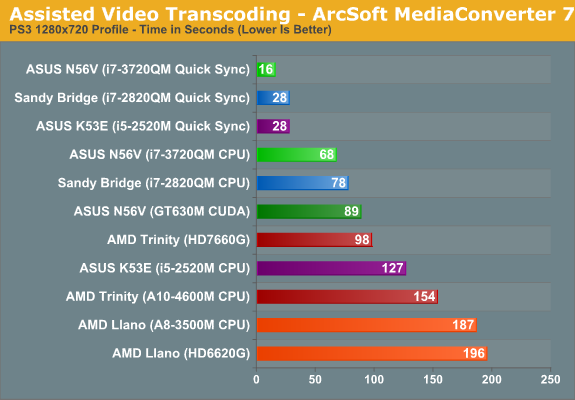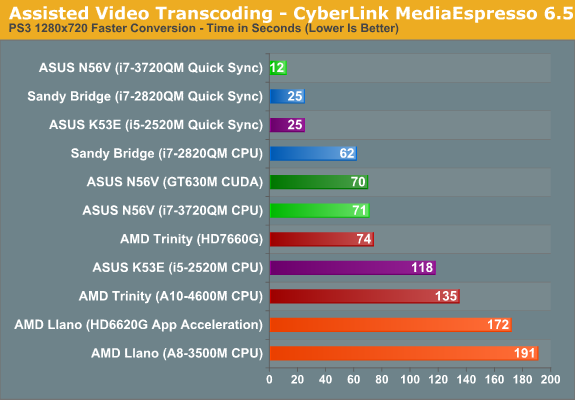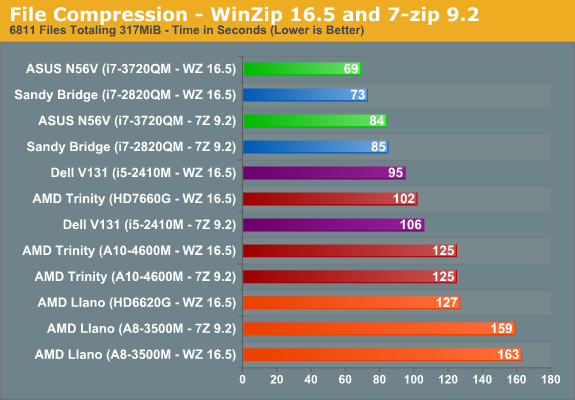The AMD Trinity Review (A10-4600M): A New Hope
by Jarred Walton on May 15, 2012 12:00 AM ESTAMD’s Heterogeneous Computing with Trinity
It’s not all about just CPU or GPU performance, though—or at least that’s what we’ve been hearing from various parties for a while now. The real question is how a platform performs as a whole. There are some tasks where pure CPU performance is what really matters, and there are other tasks where the parallel nature of GPUs pays serious dividends. AMD (and NVIDIA) has been pushing for more applications to make use of the GPU for tasks where it can provide a lot of number crunching prowess.
With Trinity, AMD provided us with a selection of applications that now leverage—to varying degrees—AMD’s App Acceleration, OpenCL, OpenGL, or other tools. For some of these applications, we don’t have any good way of measuring performance across a wide selection of hardware, and for some of those where benchmarks are possible I’ve run out of time to try to put anything concrete together. I don’t want to skip this section entirely, so what follows is a list of the applications, how they benefit from heterogeneous compute, and some general impressions of the application. We also have graphs for a few of the applications where performance seemed to matter the most.
Adobe Flash 11.2—The latest version of Flash continues to add GPU acceleration features, and now there are 3D hooks in addition to the video offload acceleration we first saw with Flash 10.x. There’s not too much of note here, as NVIDIA and Intel also support the latest features of Flash 11.2. Flash works fine on Trinity, but the same goes for Ivy Bridge and various NVIDIA GPUs. If you never saw the Epic Citadel demo for iOS or Android, there’s now a Flash-based version of the same demo that will run in your browser. (Warning: that link can take 10-15 minutes on a decent connection to download all the textures and other data!) Epic Citadel looks just as nice as it did on iOS, but now we need some actual games to take advantage of the tools. Then perhaps we can start looking into benchmarks of browser games or something….
Adobe Photoshop CS6—Photoshop started to take advantage of GPU acceleration back with the CS4 release, using OpenGL to improve performance on certain filters and features. With CS6, Adobe has begun using OpenCL. Fundamentally, I’m not sure how big of a change this represents, but there are quite a few functions in Photoshop that are now supposed to be faster/better with an OpenCL compatible graphics card. There are also two new features that leverage OpenCL; one is Iris Blur, which allows you to mimic depth of field using Photoshop instead of your camera, and the other is Liquify. Unfortunately, I’m by no means a Photoshop expert, so I’m not sure how much the features really help “power users”. I did try doing a benchmark of general Photoshop CS6 performance using the Photoshop Retouch benchmark with and without GPU acceleration enabled; unfortunately, it looks like most of the filters in that action script don’t benefit from the GPU acceleration, as the scores I got were essentially unchanged with or without GPU/OpenCL enabled. Overall, I’ll take the GPU acceleration, but for most of what I do in Photoshop it doesn’t appear to benefit; if you’re interested, you can read more about AMD’s work with Adobe.
GNU Image Manipulation Program (GIMP)—Going along with Photoshop CS6, AMD provided a special preview build of GIMP 2.8. GIMP is sort of the poor man’s Photoshop, as it’s completely free. At present, there are 19 filters that utilize OpenCL to speed of processing, and over the coming months as the release version of GIMP looks to take their new engine live there will undoubtedly be more additions. For now, probably only five of the filters are things I would use (e.g. noise reduction, maybe a light blur). I tested several of these, and there is sometimes an order of magnitude speedup vs. doing the work on just the CPU. The problem is that it also looks like GIMP isn't incredibly well threaded in many of these tasks, putting multicore CPUs at a disadvantage. My biggest complaint isn’t even about performance, though; sadly, I just find the GIMP UI and general performance to be really bad compared to Photoshop. I've tried several times over the years to use GIMP instead of Photoshop, but I’ve never felt comfortable with the tool. If on the other hand you prefer GIMP, hopefully when the current GEGL menu gets integrated into the main program you’ll realize a healthy performance boost.

ArcSoft MediaConverter 7.5—MediaConverter should be a familiar name by now if you’ve been following our reviews, as it’s one of the showcase titles for Intel’s Quick Sync transcoding. When we reviewed Ivy Bridge last month, we found that on Llano at least the version of MediaConverter we had ran slower on the GPU than on the CPU; with Trinity on the other hand, enabling GPU acceleration results in times that are about 60% faster than the CPU alone. That’s a good performance increase, but we’re looking at 154 seconds on the CPU compared to 98 seconds using the GPU. In contrast, dual-core Sandy Bridge on CPU transcoding took 127 seconds and with Quick Sync it only took 28 seconds—a 5X improvement. Quad-core Ivy Bridge was just as impressive, going from 68 seconds on the CPU down to 16 seconds with Quick Sync (4.25X). We’ve been hoping to see something more from AMD’s new Video Codec Engine (VCE), first announced over six months ago with HD 7970, but unless there’s substantial room for improvement it looks like Intel’s Quick Sync will continue to be the fastest transcoding tool for now.

CyberLink MediaEspresso 6.5—This tool is very similar to MediaConverter, and the results are also better this time around. We measured the assisted encode time at 74 seconds compared to 135 seconds on the CPU alone. The 74 second transcode time actually makes Trinity potentially faster than CPU-based transcoding on dual-core Sandy Bridge, but again Quick Sync (25 seconds on SNB, 12 seconds on IVB) remains the fastest way to transcode. Considering both of these tools are apparently using VCE, I have to state that I’m disappointed; with VCE I was expecting performance similar to what Intel is getting with Quick Sync—four or five times faster than CPU-based encoding for the same APU. That Trinity isn't quite twice as fast with VCE is unfortunate; even though there's a decent improvement, Intel is in a completely different category of performance. We’ll have to wait and see if anything more develops with VCE.

Handbrake— Yep, this popular open source video transcoding app is getting an OpenCL facelift. Check out our separate post on it here.
WinZip 16.5—This final application is one that I can see being very useful, assuming we see similar advancements in other compression utilities. WinZip 16.5 now supports OpenCL to improve compression times. We tested by compressing the entire Cinebench 11.5 directory with and without OpenCL enabled, and we also compared the results with 7-Zip. On Trinity, performance improved by about 20%, which is decent; Llano sees an even larger 28% improvement. Meanwhile, Sandy Bridge using CPU-based compression is about as fast as Trinity with OpenCL, and Ivy Bridge is still faster, but the 20% increase for “free” is nothing to scoff at. Unfortunately for WinZip, 7-Zip compressed the same directory to 95MB vs. 108MB in roughly the same time as the non-OpenCL WinZip, and 7-Zip is completely free and doesn't nag you and tell you to buy it. Where WinZip 16.5 is a good proof of concept, what will really help AMD is if all the other compression utilities (7-Zip, WinRAR, etc.) all start using OpenCL or other tools to improve performance.
The majority of the applications continue to focus on video and image manipulation, likely because those are areas where the parallel nature of GPUs can be readily utilized. WinZip on the other hand is an application showing other potential uses for GPGPU and heterogeneous compute. We’d love to see even more adoption of OpenCL and similar tools, but the stark reality is that coming up with new and useful ways of doing this is difficult—if it were easy, everyone would do it! The good news is that giving the creative people of the world more tools with which to work can only help, and we’ll just have to wait and see what else comes out.
There’s another interesting sidebar worth mentioning here. OpenCL is an open standard, and the latest Intel drivers actually install an OpenCL driver on Ivy Bridge and Sandy Bridge. Not surprisingly, not all implementations are created equal, so even with Intel’s drivers we couldn’t enable OpenCL in Photoshop or WinZip; GIMP on the other hand apparently worked okay with OpenCL on Intel—we measured a 5X performance improvement of the Noise Reduction filter with Ivy Bridge. Trinity also came in slightly faster with both leveraging OpenCL, while Intel was nearly twice as fast without.










271 Comments
View All Comments
duploxxx - Tuesday, May 15, 2012 - link
if you want a more responsive laptop then buy an SSD, no one needs a laptop like the recent released Intel QC that turbo up all the way to 3.xxx whalhalle GHZ... its disc performance that is lacking most.jabber - Tuesday, May 15, 2012 - link
Exactly.My main laptop that I use most of the day is a 1.3Ghz CULV dual core from Intel. It does everything I need as a roving PC engineer. It benches the same as an old PentiumD 2.8Ghz.
If I put a SSD in it (which I want to) then I'd probably struggle to tell it apart day to day from one with a i5 cpu in it. CPU makes no difference to me.
Since dual cores came out in 2005/6 customers dont notice CPU upgrades all that much. You put a SSD in though and they notice that. Oh and if they can play WoW or Sims with the trimmings then they love that too.
Once again is it possible to add the latest Sims game to the benchmarks list? I dont play it myself but nearly every teens laptop I get has it on and I do get asked about good laptops for such a game.
BSMonitor - Tuesday, May 15, 2012 - link
Roving PC engineer? You mean you go to meetings and look at Word Documents. That hardly makes you the "average" user. The rest of us do the actual work.Spunjji - Wednesday, May 16, 2012 - link
Look up the meaning of the word average.CeriseCogburn - Thursday, May 24, 2012 - link
I'll monitor this one - since really old cpu's are way more than enough grunt since the trinity cpu sucks so badly and amd needs another gigantic hand of endless applause and praise by many frenetic amd fans flavoring up the place, we have learned one thing -All the old laptops are just fine. If you have a discrete of any sort, just use that. Add a little cheap ram, or add an SSD and it will beat trinity no problem all the time.
I thank all the trinity lovers for the hot tip - no one needs a trinity laptop.
BSMonitor - Tuesday, May 15, 2012 - link
Not for facebooking and trolling no. But I do real work on my PC.Spunjji - Tuesday, May 15, 2012 - link
Name the part of their CPU performance that doesn't meet the "good enough" metric. Seriously, convince me of your argument. So far it sounds like the usual crap I hear from people who don't understand the average user's needs.BSMonitor - Tuesday, May 15, 2012 - link
And you speak for "average" user like you know 100 million business users. I work in an IT shop. It took years of convincing to get off our P4's to Core2Duo. Because management takes the "good enough" stance like you. Waiting for email client base on JAVA runtime is NOT acceptable. Having Adobe reader pages lag when browsing them, re-sizing, is NOT acceptable. It STILL lags behind my Core i7 machine at home. And is VERY noticeable.Again, ebay, FB, yahoo... These are not the majority of users who care about performance.
In regards to 14 y/o's and housewives, yes, trinity rules. But then so did those laptops from 6 years ago. For them.
sumguy+4 - Tuesday, May 15, 2012 - link
So you are claiming that Intel's performance has improved by only 20% over the past 6 years??!?The article's summary stated that Trinity's CPU deficit vs Intel is 20-25% (while being cheaper and offering better video perf)
Show us the mobile CPU from 6 years ago that could even come close.
juampavalverde - Tuesday, May 15, 2012 - link
Wait... youre using and email client? haha... and its based on java? LOL!. And youre using adobe reader? ROTFL!A great part of the performance comes using software that gets all the juice from the hardware you have, there is no need even in the newest systems to use so bloated software.
By the way, i have an old HP 6910p with a C2D and 2 GB DDR2, GM965, it kicks butt and im thinking to throw a cheap SSD on it because is good enough to do any task i need to do (office apps, web apps, remote connections).